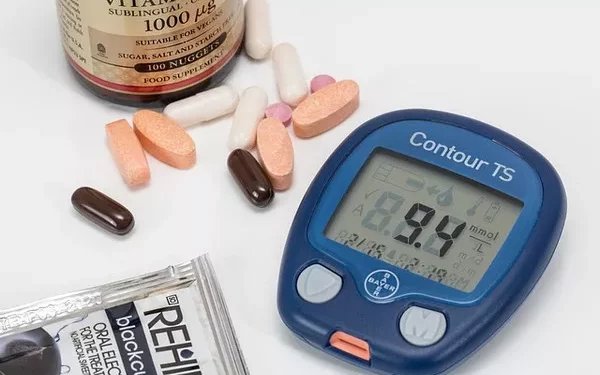Diabetic nerve pain, also known as diabetic neuropathy, is a common complication of diabetes, particularly type 2 diabetes. It occurs when high blood sugar levels cause damage to the nerves, especially in the peripheral areas such as the feet and hands. This condition can lead to symptoms like tingling, burning, numbness, and sharp pain, which can significantly affect a person’s quality of life.
Diabetic neuropathy is a progressive condition, and while it cannot be completely cured, its symptoms can be managed with the right medication and lifestyle adjustments. Proper management of diabetic nerve pain is crucial for improving quality of life and preventing further complications.
Types of Diabetic Neuropathy
There are several types of diabetic neuropathy, each affecting different parts of the body:
Peripheral Neuropathy: This is the most common type of diabetic neuropathy. It affects the nerves in the feet, legs, hands, and arms, causing symptoms such as tingling, numbness, burning, and pain.
Autonomic Neuropathy: This type affects the autonomic nervous system, which controls involuntary bodily functions like digestion, heart rate, and blood pressure. Symptoms can include gastrointestinal issues, urinary problems, and abnormal sweating.
Proximal Neuropathy: Also known as diabetic amyotrophy, this type affects the nerves in the thighs, hips, or buttocks. It can cause severe pain and muscle weakness in these areas.
Focal Neuropathy: This type affects specific nerves, usually in the head, torso, or leg. It can cause sudden weakness or pain and often resolves on its own after a few weeks or months.
Medications for Diabetic Nerve Pain
Managing diabetic nerve pain typically involves a combination of medications, lifestyle changes, and other therapies. The goal of treatment is to relieve pain, improve function, and prevent further nerve damage. Here’s an overview of the medications commonly prescribed for diabetic nerve pain:
Anticonvulsants
Anticonvulsants are often used to treat nerve pain, even though they were originally developed to manage seizures. These medications work by stabilizing the electrical activity in the nerves, thereby reducing pain signals. Common anticonvulsants prescribed for diabetic nerve pain include:
Pregabalin (Lyrica): Pregabalin is FDA-approved for the treatment of diabetic nerve pain. It is often effective in reducing pain and improving sleep. The typical dosage starts at 50 mg three times daily and can be increased based on the patient’s response and tolerance.
Gabapentin (Neurontin): Gabapentin is another anticonvulsant commonly used to treat nerve pain. It can be effective in managing symptoms, though it may take several weeks to see the full benefits. The dosage usually starts low and is gradually increased.
Carbamazepine (Tegretol): Although less commonly used, carbamazepine can be prescribed for nerve pain. It is more frequently used for trigeminal neuralgia but can be effective in diabetic neuropathy for some patients.
Antidepressants
Certain types of antidepressants have been shown to be effective in treating diabetic nerve pain, even in patients who are not depressed. These medications affect neurotransmitters in the brain and spinal cord that are involved in pain pathways. Common antidepressants used for diabetic nerve pain include:
Tricyclic Antidepressants (TCAs): Examples include amitriptyline, nortriptyline, and desipramine. TCAs are often prescribed in lower doses for pain relief than for depression. They can be effective but may cause side effects such as dry mouth, dizziness, and constipation.
Serotonin and Norepinephrine Reuptake Inhibitors (SNRIs): Examples include duloxetine (Cymbalta) and venlafaxine (Effexor). SNRIs are often well-tolerated and can help reduce pain and improve function. Duloxetine is specifically approved by the FDA for diabetic peripheral neuropathy.
Topical Treatments
Topical treatments can be applied directly to the skin over the painful areas. They are often used in combination with oral medications for more targeted pain relief. Common topical treatments include:
Capsaicin Cream: Capsaicin, derived from chili peppers, works by depleting a neurotransmitter called substance P, which is involved in transmitting pain signals. Regular use of capsaicin cream can reduce pain over time, though it may cause a burning sensation when first applied.
Lidocaine Patches: These patches contain a local anesthetic that can numb the area and reduce pain. Lidocaine patches are often used for localized pain and can be particularly helpful for patients with focal neuropathy.
Opioids and Opioid-like Medications
Opioids are generally not the first choice for treating diabetic nerve pain due to the risk of dependence and side effects. However, in cases where other treatments are not effective, opioids may be considered. Opioid-like medications such as tramadol (Ultram) are sometimes used for more severe pain. It’s important to use these medications under strict medical supervision due to the potential for abuse and addiction.
Tramadol: Tramadol is a centrally acting analgesic with a dual mechanism of action. It binds to opioid receptors and inhibits the reuptake of serotonin and norepinephrine. It is considered a less potent opioid and is used for moderate to severe pain.
Oxycodone: Oxycodone may be prescribed for severe pain that does not respond to other treatments. It is a stronger opioid and carries a higher risk of dependence, so it is typically used only when absolutely necessary.
Alpha-Lipoic Acid
Alpha-lipoic acid is an antioxidant that has been studied for its potential benefits in treating diabetic neuropathy. It is thought to reduce oxidative stress and improve nerve function. Some studies have shown that alpha-lipoic acid can help reduce pain and improve symptoms in patients with diabetic neuropathy. It is available as a supplement, but it’s important to discuss its use with a healthcare provider before starting.
Nonsteroidal Anti-Inflammatory Drugs (NSAIDs)
NSAIDs such as ibuprofen and naproxen are often used to relieve pain and inflammation. While they may not be as effective for neuropathic pain as the other medications mentioned, they can be helpful for managing mild to moderate pain or in combination with other treatments. However, long-term use of NSAIDs can lead to gastrointestinal issues and other side effects, so they should be used with caution.
Other Medications
In some cases, other medications may be used to manage diabetic nerve pain. These include:
Clonidine: Originally used to treat high blood pressure, clonidine has been found to help alleviate neuropathic pain in some patients.
Mexiletine: This antiarrhythmic medication has been used off-label to treat nerve pain. It works by blocking sodium channels and reducing nerve excitability.
Ketamine: In some cases, ketamine, an anesthetic, has been used in low doses to treat severe neuropathic pain. It is typically administered in a controlled medical setting due to its potent effects.
Non-Medication Treatments for Diabetic Nerve Pain
In addition to medication, several non-pharmacological treatments can help manage diabetic nerve pain. These include:
Physical Therapy
Physical therapy can help improve mobility and reduce pain in patients with diabetic neuropathy. Exercises and stretches designed to strengthen muscles and improve circulation can alleviate symptoms and prevent further nerve damage.
Transcutaneous Electrical Nerve Stimulation (TENS)
TENS therapy involves using a device that delivers low-voltage electrical currents to the skin. These currents interfere with pain signals, providing relief for some patients with diabetic nerve pain.
Acupuncture
Acupuncture, a traditional Chinese medicine practice, has been shown to provide relief for some patients with neuropathic pain. It involves the insertion of thin needles into specific points on the body to promote healing and pain relief.
Cognitive Behavioral Therapy (CBT)
CBT is a form of psychotherapy that helps patients manage chronic pain by changing the way they think about and respond to pain. It can be particularly helpful for patients struggling with the emotional and psychological impact of chronic pain.
Diet and Lifestyle Modifications
Maintaining tight control of blood sugar levels is crucial for managing diabetic neuropathy. A healthy diet, regular exercise, and proper diabetes management can slow the progression of nerve damage and reduce pain. Reducing alcohol consumption and quitting smoking can also have a positive impact on nerve health.
When to Seek Medical Advice
If you experience symptoms of diabetic nerve pain, it’s important to seek medical advice as soon as possible. Early intervention can help prevent further nerve damage and improve your quality of life. Your healthcare provider can help determine the most appropriate treatment plan based on the severity of your symptoms, your overall health, and your personal preferences.
See also: What Is the Most Serious Stage of Diabetes?
Conclusion
Diabetic nerve pain is a challenging condition that requires a comprehensive approach to management. While there is no one-size-fits-all solution, a combination of medications, lifestyle changes, and non-pharmacological treatments can provide significant relief for many patients. By working closely with your healthcare provider, you can find the right treatment plan to manage your symptoms and maintain your quality of life.
Understanding the various medications available for diabetic nerve pain, along with their potential benefits and side effects, is key to making informed decisions about your treatment. With proper management, you can reduce the impact of diabetic neuropathy on your daily life and prevent further complications associated with this condition.
Related topics:
What Happens with Untreated Type 2 Diabetes?



























